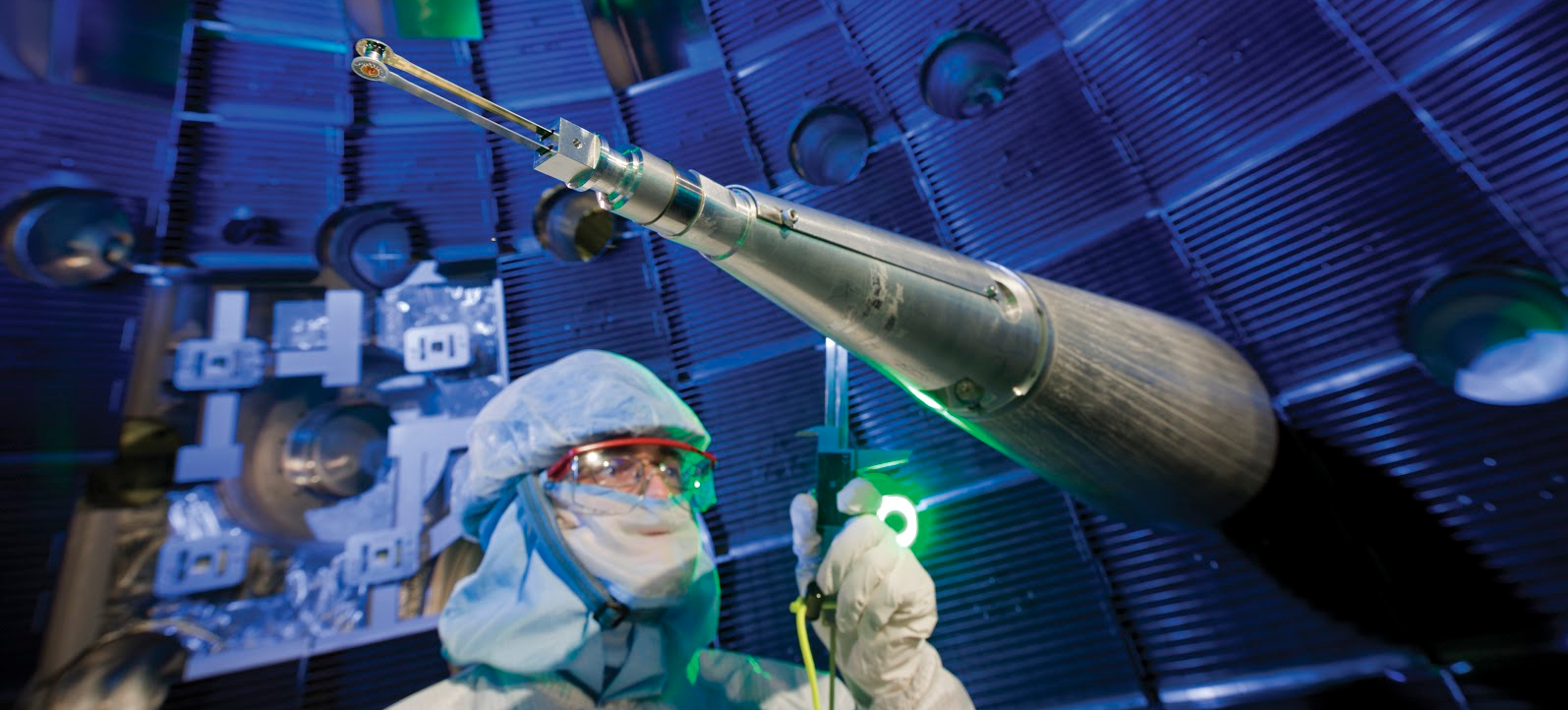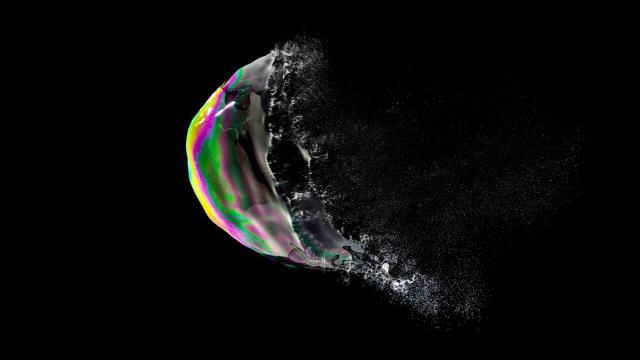Nuclear fusion is the dream of energy scientists the world over, because it promises limitless, clean electricity. Most efforts to kickstart the process use high-intensity lasers, insane magnetic field and super-hot hydrogen plasmas. But there may be a more humble alternative. It’s called sonofusion, and it involves bubbles.
Nuclear fusion is the process through which the cores of atoms, called nuclei, collide to form a new, larger atomic nucleus. When the two nuclei are of a lower mass than iron, the reaction creates energy — lots and lots of energy. For instance, when two hydrogen nuclei smash into each other, they creating a helium atom — but lose some mass, in the form of a photon, along the way. That small change in mass equates to a huge creation of energy, as predicted by Einstein’s favourite equation E=mc2. It’s this reaction that lies at the heart of our stars.
Slow Going
It’s not surprising that scientists have been trying to harness the power of fusion, especially given we’re in desperate need of clean energy. In theory, it uses very little fuel to create masses of energy with zero emissions. If it can be initiated and controlled, it could solve the energy crisis overnight. Those are, admittedly, rather large ifs, though.
There are two popular schools of thought for initiating the process. The first is inertial confinement fusion, such as that used by researchers at the National Ignition Facility in Livermore, California. There, they use 192 beams from the world’s most powerful laser to heat and compress a small pellet of hydrogen fuel until nuclear fusion reactions take place. They’re making good progress, but they’re yet to reach the point where the nuclear fusion reaction generates as much energy as the lasers supply.

The second is magnetic confinement fusion, used in centres such as the Joint European Torus, where a hydrogen mixture is pumped with heat until it reaches temperatures approaching those at the centre of the sun. The mixture becomes a plasma, and is confined to a space — usually in a ring through the centre of a torus — using incredibly high magnetic field, to keep it from touching the walls. At high enough temperatures and confinement pressures, fusion can (briefly) occur — though it still uses more energy than it creates.
The reason that making the reaction happen on Earth is so hard is that we don’t have the benefit of gravitational forces that occur at the centre of stars. There, huge quantities of matter act to correspondingly massive gravity forces acting inwards, compressing nuclei together and helping drive the reaction. Without those forces on the surface of Earth, we have to find alternative means of creating them — and holding them in place so the reaction can start. But as the hydrogen fuel implodes, interactions between hydrogen and helium atoms creates huge instabilities and shockwaves themselves, making it extremely difficult to maintain the confinement. In turn, that makes the reaction less efficient, so eventually it peters out.
Make Bubbles, Break Bubbles
There is, perhaps, an alternative. When liquid undergoes rapid changes in pressure, cavities can form — seemingly from nowhere, but usually around some kind of impurity or imperfection in the fluid. The changing pressure causes this cavity to expand and contract: this is a bubble, and its method of creation is known as cavitation. In particularly violent pressure fields, the bubble can contract so quickly and with so much force that it collapses entirely, producing a shock wave. This phenomenon’s what causes the dramatic pitting on boat propellor and water pumps, where high fluctuating pressures causes bubbles to form and collapse.
But in the controlled environment of a laboratory, the bubbles can do more than cause damage. Way back in 1934, at the University of Cologne, H. Frenzel and H. Schultes turned of the lights in their laboratory, put an ultrasound transducer in a tank of photographic developer fluid, and turned it on. They were hoping to speed up the development process of photographic film — but instead, they noticed dots of light that appeared for a split-second at a time This was the first evidence of a process called sonoluminescene, where the large quantities of energy generated by a collapsing bubble cause light to be emitted. And where there’s light, there’s energy.

It’s perhaps not surprising, then, that, scientists have since postulated that those same bubbles — if you make them big enough, and collapse hard enough — could create enough energy to kick-start the fusion process. In 1978, Hugh Flynn patented a method of generating energy by acoustically induced cavitation fusion — and it’s easy to understand why he was so enamoured with the idea. Unlike other forms of fusion, where confinement and symmetry of process is the most important aspect of the experiments, bubble-driven doesn’t care quite so much. Indeed, the theory behind the process is almost the opposite of the other technique: these bubbles are born out of instabilities. If the generation of a big enough collapse could be brought about, it could provide the initial energy required to drive fusion without much of the other techniques. It’s a deliciously tempting idea.
False Start
Perhaps, it turns out, too tempting for some. In 2002, Rusi Taleyarkhan and his researcher colleagues, then at Oak Ridge National Labs, claimed to have observed evidence of sonofusion in the laboratory. The finding came as surprise to the research community, and many seemed sceptical that the results were accurate — perhaps not least because they’d been carried out with simple, bench-top lab equipment. Nonetheless, the research was published, more papers followed, and Taleyarkhan moved to Purdue University.
Sadly, other scientists using similar equipment were unable to replicate Taleyarkhan’s work. Papers published by researchers from the University of Göttingen, UCLA, University of Illinois, and former colleagues at Oak Ridge National Labs all explained that they couldn’t observe fusion using his experimental set-up. Then, in 2006, Taleyarkhan’s results were reportedly repeated by Edward Forringer of LeTourneau University… in Taleyarkhan’s own labs at Purdue.
In 2007, so much controversy surrounded Taleyarkhan’s experiments that Purdue University launched an inquiry into his work. A panel reported that the independent verification was “highly doubtful”. Taleyarkhan called the report a “one-sided, grossly exaggerated write-up”. Ultimately, he was judged guilty of research misconduct for “falsification of the research record” in July 2008. Stripped of his full professorship,the Office of Naval Research — one of his funders — barred him from federal funding for 28 months. Taleyarkhan declined to comment about his work for this article.
The Sonofuture
A grey cloud still hangs over sonofusion. Academics working in the field — and there are certainly some — aren’t keen to talk about their work. Certainly, they all failed to answer my emails for this report. But that’s certainly not to say that research into bubble fusion is dead. Far from it.
In 2012, Markus Stokmaier from Germany’s Institute for Nuclear and Energy Studies, wrote that “it can still make sense to try to pose the sonofusion question to mother nature experimentally.” In fact, he gave Taleyarkhan some benefit of the doubt, outlining possible reasons that the experiments may have been hard to replicate, lauding aspects of the experimental set-up and suggesting improvements to the devices used to make it work better in the future.
But recently things have moved on and the sonofusion name has been cast off. First Light Fusion, for instance — a spin-out from the University of Oxford — claims to be “studying the use of intense shockwaves to crush gas-filled cavities, inducing asymmetric collapses that concentrate energy in space and time.” This is, obviously, no longer the stuff of bench-top experiments; rather, First Light Fusion is generating huge shock fronts, presumably in some kind of shock tube, that strike a bubbles and cause it to collapse catastrophically. Indeed, it claims to have “demonstrated the formation of an inertially confined plasma in a completely new and worldwide-unique geometry.” Finer details remain undisclosed, of course.
Not least because they’re not alone. In State College, Pennsylvania, Quantum Fusion is using high pressure fields in liquids to induce severe bubble collapse to the same end. In Reno, Nevada, Burst Energies has “achieved cavitation under extremely high static pressure… capable of effecting unprecedented alterations of materials, molecules and ultimately atoms for the production of fusion energy.” In Buxton, Maine, NanoSpire has announced “successful completion” of proof-of-concept experiments that show bubble cavitation could drive fusion reactions. There are, according to one academic I’ve spoken with who works on the periphery of the sector and would rather not be named, military labs works on the technique.
In contrast to Taleyarkhan’s work, all of these studies are being undertaken by private companies rather than at academic institutions. That means there’s no published work and, crucially, no real evidence about what stage the research is at. It could be years off; it could be just around the corner — it’s impossible to tell. That said, the same academic suggested to me that these pressure-driven fusion techniques could feasibly be demonstrated as successful within five to ten years.
That’s not, of course, to say that creating energy from bursting bubbles is the future of electricity production. In reality, whoever wins the race to creating a sustainable fusion reaction — whether it’s with lasers, plasma-filled doughnuts or acoustic shockwaves — will likely dominate the field, at least initially. But the fortunes of the bubble might be rising faster than some people realise.
Pictures: r.classen/Shutterstock, Lawrence Livermore National Laboratory, Dake
